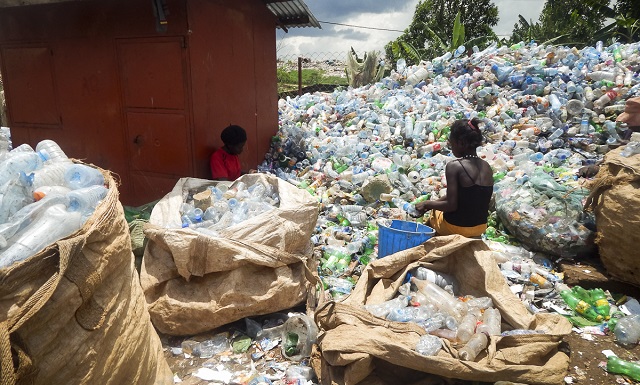
COMMENT | SARAH NEWMAN | When the world leaders gathered in Dubai for the United Nations Climate Change Conference (COP28), the United Arab Emirates unveiled the world’s highest-capacity waste-to-energy (WTE) facility. The plant is designed to process two million metric tons of municipal waste annually, producing enough electricity to power 120,000 households per year by incinerating discarded materials. Paradoxically, it is both a cutting-edge innovation and a strategy from the past.
The Dubai facility is one of thousands of WTE projects recently completed, under construction, or planned. Over 2,600 such facilities are currently operational worldwide, including more than 400 in China alone. A recent report projected rapid growth for the WTE industry, with revenues nearly doubling from $27.7 billion in 2021 to roughly $45.2 billion in 2029. That expansion will be largely owed to the global effort to meet the Paris climate agreement’s targets, which has fueled increased investment in sustainable waste-management solutions.
This bodes well for the battle against climate change. WTE facilities currently process more than 400 million tons of waste annually, accounting for roughly 20% of the two billion tons of residual waste remaining each year after reuse, composting, and recycling. Decomposing waste in landfills emits methane, a gas with 28 times the warming potential of carbon dioxide. Redirecting waste materials to WTE facilities helps to reduce methane emissions, as well as conserve land and generate electricity.
This is good news, but it is also old news. WTE facilities are adaptations of earlier concepts rather than revolutionary innovations. They are humanity’s latest attempt to eliminate waste instead of preventing it in the first place. In my recent book, Unmaking Waste, I chronicle this centuries-long quest to transform profligate consumption into a positive force.
In the early twentieth century, for example, multiple US cities invested in what were known as “reduction” plants, which compressed trash to extract oils and other byproducts for use as fertilizers, lubricants, and even perfume bases. At the time, this process was viewed as a major advance in waste management. As the Chairman of the New Orleans Committee on Health put it during the 1898 Convention of the League of American Municipalities, the burgeoning field offered the “glowing promises of rich rewards.” Similarly, landfills, frequently maligned nowadays, were viewed as a way to recover valuable resources and reclaim usable land.
But this approach proved to be unsustainable in the long run. The reduction plants, which “cooked” vast quantities of decaying waste to extract grease and oil, produced pungent odors and polluted nearby waterways with liquid runoff from the compression process.
Incineration, the core technology behind today’s WTE facilities, has long been touted as a sanitary, efficient, and profitable method of waste disposal. In the late nineteenth century, many public officials and sanitary engineers lauded the power of fire not only to destroy and purportedly disinfect waste but also to generate steam for powering various types of engines.
Like the nineteenth-century waste-reduction facilities, however, incineration failed to live up to its potential. Burning organic materials, which typically contain lots of water, required higher temperatures than what garbage alone could produce. This forced plants to augment their garbage with coal and other fuels, driving up costs. Alternatively, plants could operate at lower temperatures, which resulted in partly incinerated waste, along with increased smoke and gas emissions. These challenges made converting waste to steam and electrical energy more expensive than simply burning wood and coal. Nearly 60% of the incinerators built around the turn of the twentieth century were abandoned or dismantled by 1910.
WTE facilities have encountered similar setbacks. For example, a proposed plant in the Bahamas was initially projected to require 1,500 metric tons of combustible waste per day to offset its own energy consumption, a figure that exceeded the entire country’s daily waste production by 1,000 metric tons. In the United Kingdom, ambitious plans for two WTE plants were scrapped, at a cost of nearly $1 billion, after the first completed unit produced much less electricity than expected.
WTE technologies continue to improve, particularly in reducing toxic emissions. Still, the parallels between the late nineteenth century and today are striking. In 1888, S.S. Kilvington, then-president of the American Public Health Association, delivered an impassioned speech in which he foresaw a transition from an “age of filth-formation” to an “era of filth-destruction,” in which fire would purify both the “refuse of the living and the remains of the dead.”
More than 130 years later, Sheikh Hamdan bin Mohammed Al Maktoum, the crown prince of Dubai, echoed Kilvington’s optimism as he inaugurated the UAE’s new WTE facility. Highlighting the plant’s ability to process millions of tons of waste “without any adverse environmental impact,” Al Maktoum lauded its role in promoting “a brighter and more sustainable future.”
As the waste crisis becomes increasingly visible, with mountains of discarded clothes in the Atacama Desert and enormous swirling gyres of plastic in the Pacific Ocean – large enough to generate their own ecosystems – WTE facilities are often hailed as sustainable alternatives to disposal on land or at sea. But while these facilities are an improvement over traditional waste-management methods, they are not solutions. They address the symptoms rather than the disease.
Switzerland is a case in point. While the country has successfully phased out landfills, its municipal solid waste per capita – especially plastics, which it incinerates instead of recycling – continues to increase.
Despite numerous technological advances, our methods of waste disposal have remained fundamentally unchanged for centuries. Vast amounts of knowledge, time, and money have been invested in producing things designed to be thrown away.
What would the coming century look like if these resources were redirected toward getting rid of the idea of waste altogether? Already we can have clothes made from milk waste, furniture grown from mushroom mycelium, and bioplastics produced from seaweed and saltwater microbes and watermelon rinds. If we want solutions, we cannot rely on the same ideas that have generated the problems in the first place. We must fundamentally change how we produce waste, not just how we manage it.
*****
 Sarah Newman is Assistant Professor of Anthropology at the University of Chicago.
Sarah Newman is Assistant Professor of Anthropology at the University of Chicago.© Project Syndicate 1995–2023
 The Independent Uganda: You get the Truth we Pay the Price
The Independent Uganda: You get the Truth we Pay the Price



